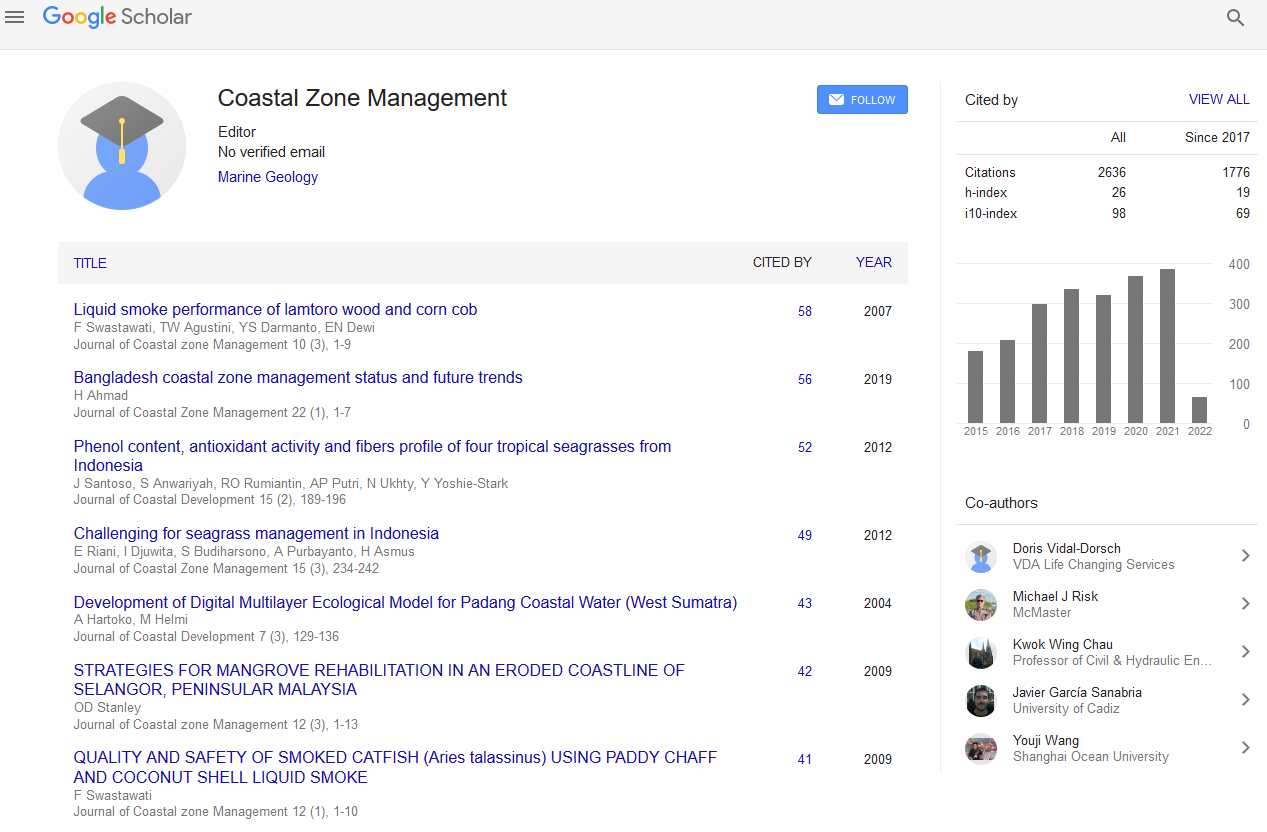Indexed In
- SafetyLit
- RefSeek
- Hamdard University
- EBSCO A-Z
- OCLC- WorldCat
- Publons
Useful Links
Share This Page
Journal Flyer

Open Access Journals
- Agri and Aquaculture
- Biochemistry
- Bioinformatics & Systems Biology
- Business & Management
- Chemistry
- Clinical Sciences
- Engineering
- Food & Nutrition
- General Science
- Genetics & Molecular Biology
- Immunology & Microbiology
- Medical Sciences
- Neuroscience & Psychology
- Nursing & Health Care
- Pharmaceutical Sciences
Abstract
Climate Change Impacting on Island Liveable Communities and Geographical Structures in Next Decades- Kachireddy Venkata Nageswara Reddy- Engineering Staff College of India
Kachireddy Venkata Nageswara Reddy
World governance is taking too much of time for providing solution to Climate Change (CC) why because, they are not recognized / treating the entire planet as a single laboratory for this CC study. The delay is impacting planet geographical structure and communities. One among them is “Island Communities (Traditions)”. These communities recognize density after a huge impact and migrating as refugees to other places, which is again increasing density and rivalry with local communities. Many people losing their lives, belongings and livelihood rights. It is the time to think about climate change solutions for sustainable Development in all parts (Islands, Glaciers, Countries, Mountains, Deserts…) of the planet. Else, the stupidity spreads clashes between species and communities. This paper explains about the importance of Climate Change for Sustainable Development in any specific area (Village / Town / City / State / Country), it includes their Culture, Food security, Natural Resources, Business for employment and Economy. Also, concludes Climate Change solution is an origin for Sustainable Development on this planet.
There are numerous optional impacts of environmental change and ocean level ascent specific to island countries. As per the US Fish and Wildlife Service environmental change in the Pacific Islands will cause "proceeded with increments in air and sea surface temperatures in the Pacific, expanded recurrence of outrageous climate occasions, and expanded precipitation throughout the late spring months and a decline in precipitation throughout the cold weather months". This would involve particular changes to the little, different and segregated island environments and biospheres present inside large numbers of these island countries. As ocean level ascents island countries are at expanded danger of losing beach front arable land to corruption just as salinification. When the restricted accessible soil on these islands is salinified it turns out to be extremely hard to create means harvests, for example, breadfruit. This would seriously affect the horticultural and business area in countries, for example, the Marshall Islands and Kiribati. Likewise, neighborhood fisheries would likewise be seriously influenced by higher sea temperatures and expanded sea fermentation. As sea temperatures rise and the pH of seas diminishes, many fish and other marine species would vanish or change their propensities and reach. Just as this, water supplies and neighborhood environments, for example, mangroves, are undermined by an Earth-wide temperature boost. The travel industry area would be especially compromised by expanded events of outrageous climate occasions, for example, storms and dry seasons.
It is currently broadly acknowledged by mainstream researchers that the Earth is going through exceptional environmental change because of expanded ozone harming substance discharges. Changes in worldwide environment have happened a few times all through the Earth's set of experiences however have extended throughout significant stretches of time though as of now these progressions are occurring over the space of a century or less. This quick change, related with different dangers coming about because of human action identified with creation and utilization, are unequivocally affecting biodiversity. Considered as one of the five fundamental driver of species and populaces misfortunes, environmental change may prompt direct adjustments of regular natural surroundings, compelling species to move from their authentic reach, adjust to new ecological conditions, discover shelter in unaltered microhabitats or may prompt species termination. Critically, environmental change acts in cooperative energy with other human-instigated dangers, for example, land use strengthening or natural intrusion, expanding their belongings.
In this unique circumstance, island biodiversity requires explicit consideration for a few reasons. Separate people group, since they are spatially isolated and have developed in disengagement, are described by very high paces of endemism. Despite the fact that they happen on under 5% of the Earth's earthbound region, island plants and vertebrates have an endemic lavishness that may surpass that of terrain species by a factor of 9.515. Island biota are likewise exceptionally inclined to elimination: around 80% of past annihilations and 33% of undermined earthbound species are found on islands16. Past eradications were likely set off by intrusive species, the gullibility of separate species, and the high reach limitation of certain populaces. In spite of the fact that environmental change may affect island biota from various perspectives, almost certainly, ocean level ascent and environment movements will be critical because of their immediate relationship with the accessibility of reasonable natural surroundings for earthbound creatures. Ocean level ascent is relied upon to prompt the submergence of a few islands. Ocean level ascent may likewise increment seaside disintegration and saline water interruption, affecting common territories. This implies that rise, territory, and the unpredictability of shoreline deltas are vital with respect to weakness to the ocean level ascent.
Published Date: 2021-01-28;

